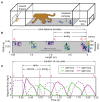Spatiotemporal scaling changes in gait in a progressive model of Parkinson's disease
- PMID: 36582611
- PMCID: PMC9792983
- DOI: 10.3389/fneur.2022.1041934
Spatiotemporal scaling changes in gait in a progressive model of Parkinson's disease
Abstract
Objective: Gait dysfunction is one of the most difficult motor signs to treat in patients with Parkinson's disease (PD). Understanding its pathophysiology and developing more effective therapies for parkinsonian gait dysfunction will require preclinical studies that can quantitatively and objectively assess the spatial and temporal features of gait.
Design: We developed a novel system for measuring volitional, naturalistic gait patterns in non-human primates, and then applied the approach to characterize the progression of parkinsonian gait dysfunction across a sequence of 1-methyl-4-phenyl-1,2,3,6-tetrahydropyridine (MPTP) treatments that allowed for intrasubject comparisons across mild, moderate, and severe stages.
Results: Parkinsonian gait dysfunction was characterized across treatment levels by a slower stride speed, increased time in both the stance and swing phase of the stride cycle, and decreased cadence that progressively worsened with overall parkinsonian severity. In contrast, decreased stride length occurred most notably in the moderate to severe parkinsonian state.
Conclusion: The results suggest that mild parkinsonism in the primate model of PD starts with temporal gait deficits, whereas spatial gait deficits manifest after reaching a more severe parkinsonian state overall. This study provides important context for preclinical studies in non-human primates studying the neurophysiology of and treatments for parkinsonian gait.
Keywords: MPTP; Parkinson's disease; gait; non-human primate; pressure walkway.
Copyright © 2022 Doyle, Bauer, Hendrix, Yu, Nebeck, Fergus, Krieg, Wilmerding, Blumenfeld, Lecy, Spencer, Luo, Sullivan, Brackman, Ross, Best, Verma, Havel, Wang, Johnson, Vitek and Johnson.
Conflict of interest statement
The authors declare that the research was conducted in the absence of any commercial or financial relationships that could be construed as a potential conflict of interest.
Figures




Similar articles
-
Quantitative assessment of gait and neurochemical correlation in a classical murine model of Parkinson's disease.BMC Neurosci. 2012 Nov 14;13:142. doi: 10.1186/1471-2202-13-142. BMC Neurosci. 2012. PMID: 23151254 Free PMC article.
-
Severe long-term 1-methyl-4-phenyl-1,2,3,6-tetrahydropyridine-induced parkinsonism in the vervet monkey (Cercopithecus aethiops sabaeus).Neuroscience. 1997 Dec;81(3):745-55. doi: 10.1016/s0306-4522(97)00214-5. Neuroscience. 1997. PMID: 9316026
-
Cerebral metabolic pattern associated with progressive parkinsonism in non-human primates reveals early cortical hypometabolism.Neurobiol Dis. 2022 Jun 1;167:105669. doi: 10.1016/j.nbd.2022.105669. Epub 2022 Feb 24. Neurobiol Dis. 2022. PMID: 35219857
-
The actions of 1-methyl-4-phenyl-1,2,3,6-tetrahydropyridine in animals as a model of Parkinson's disease.J Neural Transm Suppl. 1986;20:11-39. J Neural Transm Suppl. 1986. PMID: 3091760 Review.
-
[Gait disorders in Parkinson's disease: and pathophysiological approaches].Rev Neurol (Paris). 2010 Feb;166(2):158-67. doi: 10.1016/j.neurol.2009.05.010. Epub 2009 Jul 18. Rev Neurol (Paris). 2010. PMID: 19616816 Review. French.
Cited by
-
Lewy bodies, iron, inflammation and neuromelanin: pathological aspects underlying Parkinson's disease.J Neural Transm (Vienna). 2023 May;130(5):627-646. doi: 10.1007/s00702-023-02630-9. Epub 2023 Apr 16. J Neural Transm (Vienna). 2023. PMID: 37062012 Free PMC article. Review.
-
Effect of subthalamic coordinated reset deep brain stimulation on Parkinsonian gait.Front Neuroinform. 2023 Aug 24;17:1185723. doi: 10.3389/fninf.2023.1185723. eCollection 2023. Front Neuroinform. 2023. PMID: 37692361 Free PMC article.
References
Grants and funding
LinkOut - more resources
Full Text Sources

